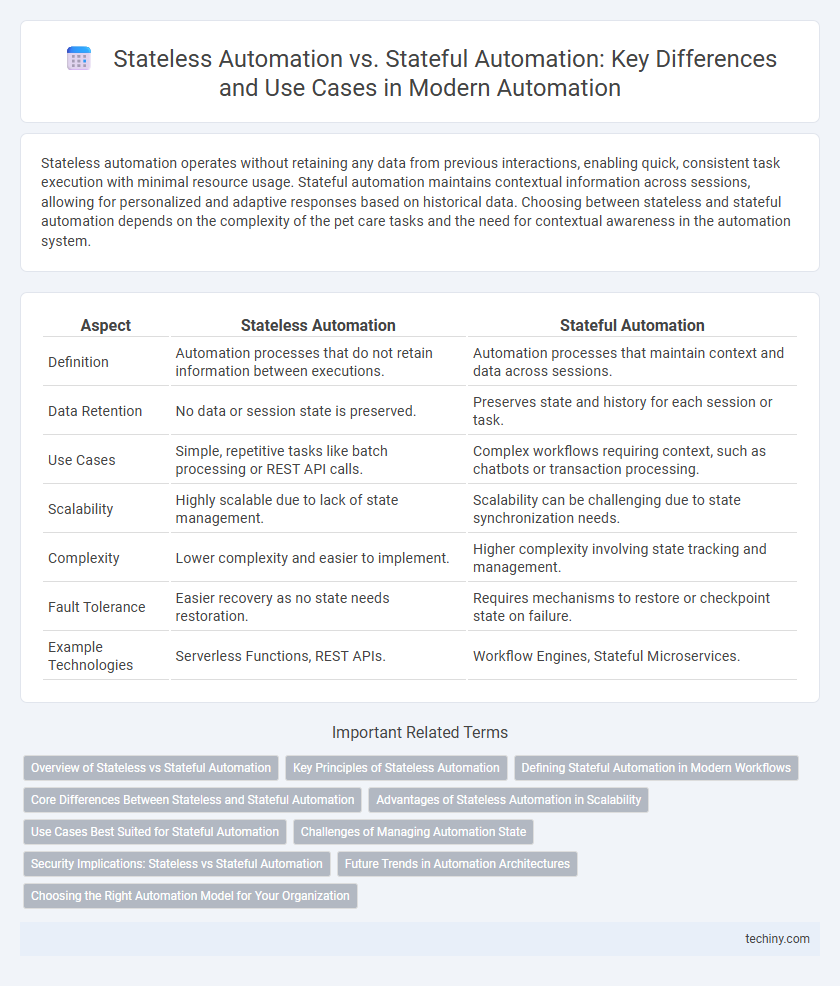Stateless automation operates without retaining any data from previous interactions, enabling quick, consistent task execution with minimal resource usage. Stateful automation maintains contextual information across sessions, allowing for personalized and adaptive responses based on historical data. Choosing between stateless and stateful automation depends on the complexity of the pet care tasks and the need for contextual awareness in the automation system.
Table of Comparison
| Aspect | Stateless Automation | Stateful Automation |
|---|---|---|
| Definition | Automation processes that do not retain information between executions. | Automation processes that maintain context and data across sessions. |
| Data Retention | No data or session state is preserved. | Preserves state and history for each session or task. |
| Use Cases | Simple, repetitive tasks like batch processing or REST API calls. | Complex workflows requiring context, such as chatbots or transaction processing. |
| Scalability | Highly scalable due to lack of state management. | Scalability can be challenging due to state synchronization needs. |
| Complexity | Lower complexity and easier to implement. | Higher complexity involving state tracking and management. |
| Fault Tolerance | Easier recovery as no state needs restoration. | Requires mechanisms to restore or checkpoint state on failure. |
| Example Technologies | Serverless Functions, REST APIs. | Workflow Engines, Stateful Microservices. |
Overview of Stateless vs Stateful Automation
Stateless automation executes tasks without retaining data or context between runs, enabling rapid, scalable processes ideal for repetitive and independent workflows. Stateful automation maintains contextual information and session states, allowing for more complex, condition-dependent operations that require tracking progress over time. Choosing between stateless and stateful automation depends on the complexity of the task, system design, and the necessity of data continuity for accurate execution.
Key Principles of Stateless Automation
Stateless automation operates under the principle that each process execution is independent, ensuring workflows do not retain session information or state between executions. This design enhances scalability and fault tolerance by enabling automated tasks to restart or be retried without dependency on prior context. Core principles include idempotency, seamless retry mechanisms, and decoupling of system components to maintain flexibility and reduce complexity in automation pipelines.
Defining Stateful Automation in Modern Workflows
Stateful automation maintains context and tracks the status of processes across multiple interactions, enabling more complex and dynamic workflows in modern automation environments. By preserving state information, it supports decision-making based on previous events, user inputs, or system conditions, enhancing personalization and adaptability in business processes. Stateful automation is critical for scenarios such as customer service bots, order processing, and continuous system monitoring where ongoing context awareness drives efficiency and user experience.
Core Differences Between Stateless and Stateful Automation
Stateless automation executes processes without retaining data between interactions, ensuring faster response times and easier scalability by treating each task independently. Stateful automation maintains session information and historical context, enabling more complex workflows that depend on prior inputs and system states for decision-making. The core difference lies in the management of data persistence, where stateless systems prioritize simplicity and speed, while stateful systems focus on contextual awareness and continuity.
Advantages of Stateless Automation in Scalability
Stateless automation enhances scalability by enabling systems to handle increased workloads without retaining session-specific information, reducing resource consumption and simplifying load balancing. It allows for easier replication and deployment across multiple servers since each automation instance operates independently without dependency on past interactions. This approach ensures faster scaling and improved fault tolerance in distributed environments, making it ideal for cloud-native and microservices architectures.
Use Cases Best Suited for Stateful Automation
Stateful automation is best suited for complex workflows requiring continuous context tracking, such as customer support systems, real-time fraud detection, and dynamic inventory management. These use cases benefit from maintaining the system's state over time to ensure accurate decision-making based on historical interactions. Stateful automation enables personalized user experiences and adaptive processes that evolve with ongoing data input and events.
Challenges of Managing Automation State
Managing state in stateful automation presents challenges such as increased complexity in tracking system status and handling data persistence across workflows. Stateless automation simplifies these issues by eliminating the need to maintain session information, enhancing scalability and fault tolerance. However, stateless designs may struggle with use cases requiring continuous context, demanding careful architectural decisions to balance performance and reliability.
Security Implications: Stateless vs Stateful Automation
Stateless automation enhances security by minimizing attack surfaces as each operation is independent, eliminating the risk of unauthorized data persistence or state manipulation. Stateful automation, while offering context-rich functionality, increases vulnerability through stored session data that can be targeted for breaches or state tampering. Implementing stateless architectures reduces risks associated with data leakage, unauthorized access, and session hijacking, making it preferable for high-security automation environments.
Future Trends in Automation Architectures
Future trends in automation architectures emphasize a shift towards stateless automation due to its scalability, improved fault tolerance, and simplified maintenance. Stateful automation, while still critical for complex processes requiring memory of past interactions, is increasingly integrated with edge computing and AI-driven analytics to enhance decision-making capabilities. Hybrid models combining stateless and stateful elements are emerging, optimizing resource efficiency and enabling adaptive systems in dynamic industrial environments.
Choosing the Right Automation Model for Your Organization
Choosing between stateless and stateful automation depends on your organization's operational complexity and data management needs. Stateless automation offers scalability and simplicity by processing tasks without retaining session information, ideal for repetitive, independent workflows. Stateful automation, maintaining context throughout processes, suits complex environments requiring continuous interaction and real-time decision-making.
Stateless Automation vs Stateful Automation Infographic

 techiny.com
techiny.com